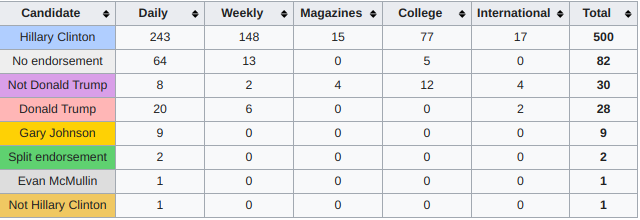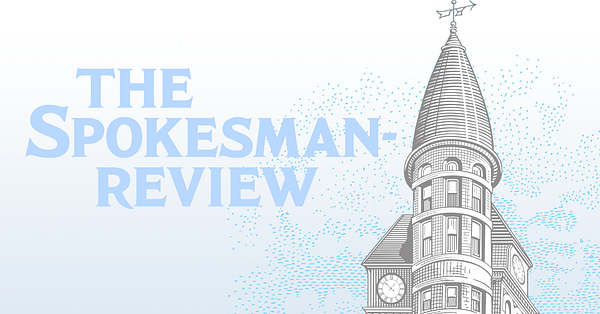What's a newspaper presidential endorsement worth?
Not much, really. And yet every four years we go through the motions.
As we’re eight days away from “the most important election of our lifetime”™, it’s also time for the ritualistic newspaper editorial board presidential endorsement.
One of the (many) things we should have learned from the 2016 presidential cyclone is that newspaper endorsements don’t matter anymore.

(Image via Wikipedia)
Sure, as once upon a time, there may have been an argument that a newspaper carried the weight of ideas and convinced people that they should vote this way or that. Of course, that would completely ignore other factors that would go into how people got their information: church, bars, work, etc. But yes, an endorsement by a paper back when newspapers were the only mass media game in town probably mattered.
Today, it’s clear they don’t. But that’s not stopping newspapers to feel important and provide their thoughts on which candidate you should vote for.
This year is shaping up to be no different than 2016 in how newspapers have decided that they cannot endorse an incumbent president who has:
Been impeached;
Oversaw the national debt balloon to $27 trillion, up 36 percent in four years;
Mismanaged the response to a pandemic that has killed more than 200,000 Americans and affected tens of millions through loss of work, benefits, etc;
Averaged more than 50 lies per day since he’s been office, nearing 25,000.
As of today, there are only six publications that are endorsing Trump for reelection. One is not really an editorial board:
Nieman Lab’s Josh Benton has an excellent thread on the Spokane Spokesman Review, which urges its readers to vote for Trump, even though he’s “a bully and bigot.” (Clearly characteristics we all want in leaders.)


And the New York Post has a full-throated endorsement (which, obviously), with mental gymnastics such as
A Joe Biden administration would be beholden to a socialist left that sees an opportunity to remake the nation in its vision, one more dependent on government debt.
Clearly, the Post lives in a different reality where the president hasn’t placed three Supreme Court justices, giving the bench a 6-3 conservative lock for decades to come; nor has the national debt, as mentioned above, grown so high.
Last week, USA Today, for the first time in its almost 40 years, endorsed a candidate for president: Joe Biden. And the New Hampshire Union Leader, what Fox News calls “one of the nation’s most prominent conservative-leaning newspapers,” endorsed Joe Biden.
While trust in media continues to crater, it’s an interesting phenomenon how media companies believe that they wield enough linguistic and rhetorical power to convince its readers to vote for a particular candidate.
When we get our information in 240-character aphorisms and random newsletters (hello!), not to mention social platforms, TV, radio, blogs, streaming channels, how much weight will we actually place on a newspaper editorial endorsement?
Remember when the New York Times endorsed both Amy Klobuchar and Elizabeth Warren for the Democratic presidential nominee?
According to a 2019 Big Think post, there is some research that could indicate that some people can be swayed; but there are lots of grains of salt in this argument:
A 2008 study from Brown University indicated that endorsements can change people's opinions. However, the effect is limited if the endorsement is expected. If a major newspaper in a cosmopolitan city known for having a center-left leaning editorial board endorses a Democrat for president not much will happen. On the other hand, a neutral or even right-leaning editorial board doing the same thing can carry great weight.
Northwestern also did a report on prediction markets and found that there are changes in who is more likely to win the race for president as a result of newspaper endorsements. Like Brown, they found that surprising endorsements had the most effect.
This said, however, a study by Pew Research Center found that 70 percent of people didn't feel influenced by endorsements at all. The remaining percentage were split on whether the newspaper's support would make them more or less likely to vote for the candidate.
In February, Dan Kennedy wrote at WGBH that:
My own view, having written many endorsements over the course of my career, is that they are of no value in high-profile contests such as president, governor or U.S. senator. Those are the races that voters follow most closely, and it's not likely that the anonymous, institutional voice of the newspaper is going to change their mind. On the other hand, endorsements can have real impact in more obscure local races such as city council or school committee. Yet such endorsements seem to have all but disappeared, probably because cash-strapped news organizations fear alienating any of their readers. (The Globe, to its credit, still does them.)
After the 2016 election, as newspapers did their postmortems, Columbia Journalism Review spoke with editors about the endorsement-as-vote-swayer and heard a common refrain:
“I’m often perplexed by news articles and columns about endorsements because they assume that organizations like ours endorse candidates for one reason: to sway votes,” Chicago Tribune Editorial Page Editor John McCormick explains. “If that’s the metric, then your verdict will be easy to reach: ‘But people don’t pay any attention, it’s irrelevant, half of the people you endorse don’t win.’ Those clichés are the hardiest of perennials. Swaying votes is only one reason for endorsing, and arguably not the most important. Every few years, endorsements bring a publication to full stop. They explain to the world what that publication is, what it advocates, how it thinks, what principles it holds dear.”
This has some merit if you believe that the newspaper is the only way a citizenry gets information. It also ignores the reality that people aren’t reading local publications (see: news deserts), as they used to.
At this stage of the media life cycle, editorial endorsements are clearly a vestige of a long ago time when they were the ones who controlled what information was considered worthy of discussion.
As media continues to involve—whether that’s its business model or its approach to journalism—it’s ok for sacred cows, like the editorial presidential endorsement, to go out to pasture.
Thank you for allowing me in your inbox, today and everyday. If you have tips, thoughts on the newsletter, or want to endorse me for president, send me an email. Or you can follow me on Twitter. If you appreciated this edition, please consider sharing across your social networks and get your colleagues to sign up. Thanks for reading!
Frank Sinatra, “High Hopes”
Some interesting links:
For political ads:
Brad Pitt narrates new Biden campaign ad airing during World Series (CNN)
'Sue if you must': Lincoln Project rejects threat over Kushner and Ivanka billboards (The Guardian)
For brands:
Dunkin to sell to private equity (NYT)
For buyers:
TV ad buyers expect networks to tax upfront advertisers that waited to commit (Digiday)
For publishers:
Vice gets squeezed (Air Mail)
Trump Had One Last Story to Sell. The Wall Street Journal Wouldn’t Buy It. (NYT)
The White Issue: Has Anna Wintour’s Diversity Push Come Too Late? (NYT)
For former presidents who write books:
A president looks back on his toughest fight (The New Yorker)



